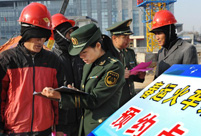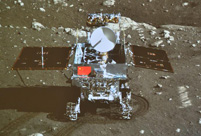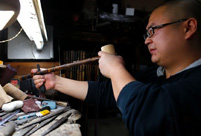 'Jin' named the word of the year by cross-strait netizens
'Jin' named the word of the year by cross-strait netizens Chinese scientific expedition goes to build new Antarctica station
Chinese scientific expedition goes to build new Antarctica station
 Chinese naval escort fleet conducts replenishment in Indian Ocean
Chinese naval escort fleet conducts replenishment in Indian Ocean 17th joint patrol of Mekong River to start
17th joint patrol of Mekong River to start China's moon rover, lander photograph each other
China's moon rover, lander photograph each other Teaming up against polluters
Teaming up against polluters
International competition is not only reflected in the economy, but also in science and technology. The successful moon landing of Chang'e-3, China’s lunar probe, has provided great inspiration to the Chinese people’s self image and has also boosted national pride and prestige.
After more than 60 years of development dating back to the founding of the People’s Republic of China, China has established a path to independent innovation with its own characteristics, and has become one of the leading nations in science and technology. China is now gradually narrowing the gap with the U.S.
What is China’s path to independent innovation?
China has implemented various science and technology strategies at different stages of the country's development: developing China via science and technology; rejuvenating the nation through science and technology; strengthening China by science and technology (also termed innovation-driven development). On the road to the global technology revolution, China is one of the few countries implementing independent innovation policies.
In addition, China has adopted different policies at different times: taking the path of self-reliance; opening-up to the outside world; independent innovation; re-innovation based on primary innovation.
Furthermore, China’s science and technology system has undergone several changes. In recent decades, China has enhanced its competitiveness through purchasing and introducing technology from abroad, through post-deployment re-engineering, and through introducing and improving independent innovation capability.
From 1949 to 1959, China imported technology mainly from the Soviet Union and began the first stages of developing its own technological capability.
Between 1960 and 1965 the Soviet Union interrupted technical assistance and exports to China, and China began to strengthen its independent development capability, targeted at catching up with advanced technology.
From 1966 to 1976, the Cultural Revolution greatly weakened China's independent technical ability. Although China began to reintroduce technology from Western countries after 1972, there remained a substantial gap with developed countries.
From 1977, China began large-scale introduction of foreign technology, but at the same time decreased its input in research and development.
On entering the 21st century, and especially after joining the World Trade Organization, China began a significant expansion to its capacity to introduce technology, and in particular to its capacity for re-innovation. Most importantly, China has greatly strengthened its capacity for independent technical innovation, and has begun to catch up with the developed countries. In many areas, China now keeps pace with advanced international technology.
Therefore, whether with reference to the past or in visioning the future, whether in the domestic Chinese context or in the environment of the wider world, China must embark on a road to independent innovation.
The author is Hu Angang, director of the Research Center for Contemporary China at Tsinghua University.
 People prepare for upcoming 'Chunyun'
People prepare for upcoming 'Chunyun'  Highlights of Beijing int'l luxury show
Highlights of Beijing int'l luxury show Record of Chinese expressions in 2013
Record of Chinese expressions in 2013 China's moon rover, lander photograph each other
China's moon rover, lander photograph each other 17th joint patrol of Mekong River to start
17th joint patrol of Mekong River to start Spring City Kunming witnesses snowfall
Spring City Kunming witnesses snowfall Heritage of Jinghu, arts of strings
Heritage of Jinghu, arts of strings Weekly Sports Photos
Weekly Sports Photos PLA elite units unveiled
PLA elite units unveiled  China's stealth fighters hold drill over plateau
China's stealth fighters hold drill over plateau Chinese navy hospital ship's mission
Chinese navy hospital ship's mission  "Free lunch" program initiated in NW China
"Free lunch" program initiated in NW China  Rime scenery in Mount Huangshan
Rime scenery in Mount Huangshan DPRK's Kaesong Industrial Complex
DPRK's Kaesong Industrial Complex 'Jin' named the word of the year
'Jin' named the word of the year Day|Week|Month